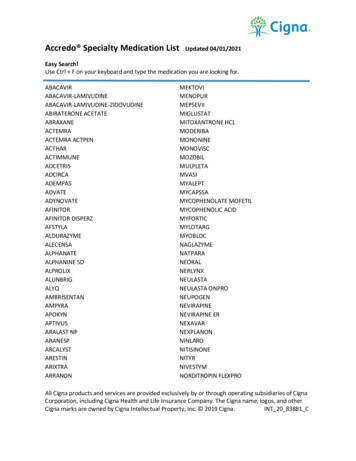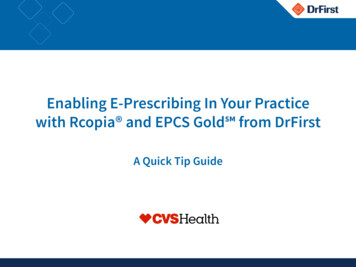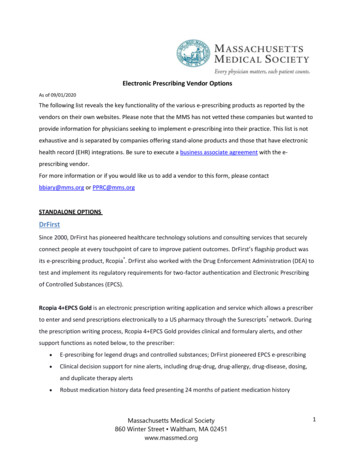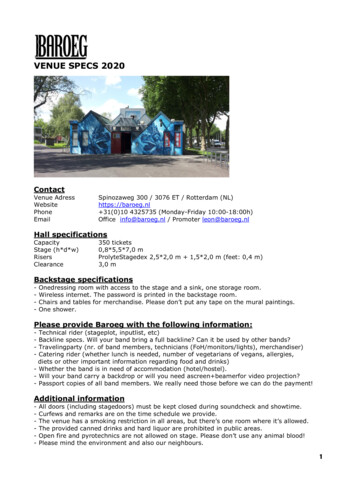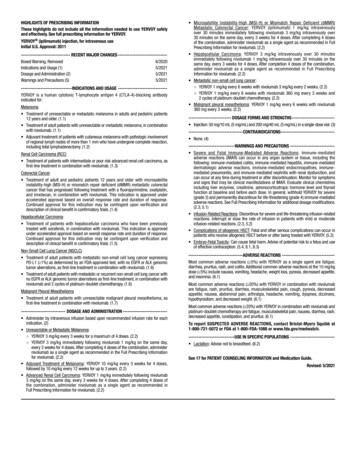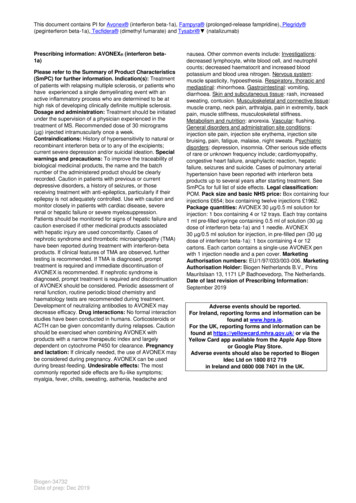
Transcription
This document contains PI for Avonex (interferon beta-1a), Fampyra (prolonged-release fampridine), Plegridy (peginterferon beta-1a), Tecfidera (dimethyl fumarate) and Tysabri (natalizumab)Prescribing information: AVONEX (interferon beta1a)Please refer to the Summary of Product Characteristics(SmPC) for further information. Indication(s): Treatmentof patients with relapsing multiple sclerosis, or patients whohave experienced a single demyelinating event with anactive inflammatory process who are determined to be athigh risk of developing clinically definite multiple sclerosis.Dosage and administration: Treatment should be initiatedunder the supervision of a physician experienced in thetreatment of MS. Recommended dose of 30 micrograms(µg) injected intramuscularly once a week.Contraindications: History of hypersensitivity to natural orrecombinant interferon beta or to any of the excipients;current severe depression and/or suicidal ideation. Specialwarnings and precautions: To improve the traceability ofbiological medicinal products, the name and the batchnumber of the administered product should be clearlyrecorded. Caution in patients with previous or currentdepressive disorders, a history of seizures, or thosereceiving treatment with anti-epileptics, particularly if theirepilepsy is not adequately controlled. Use with caution andmonitor closely in patients with cardiac disease, severerenal or hepatic failure or severe myelosuppression.Patients should be monitored for signs of hepatic failure andcaution exercised if other medicinal products associatedwith hepatic injury are used concomitantly. Cases ofnephrotic syndrome and thrombotic microangiopathy (TMA)have been reported during treatment with interferon-betaproducts. If clinical features of TMA are observed, furthertesting is recommended. If TMA is diagnosed, prompttreatment is required and immediate discontinuation ofAVONEX is recommended. If nephrotic syndrome isdiagnosed, prompt treatment is required and discontinuationof AVONEX should be considered. Periodic assessment ofrenal function, routine periodic blood chemistry andhaematology tests are recommended during treatment.Development of neutralizing antibodies to AVONEX maydecrease efficacy. Drug interactions: No formal interactionstudies have been conducted in humans. Corticosteroids orACTH can be given concomitantly during relapses. Cautionshould be exercised when combining AVONEX withproducts with a narrow therapeutic index and largelydependent on cytochrome P450 for clearance. Pregnancyand lactation: If clinically needed, the use of AVONEX maybe considered during pregnancy. AVONEX can be usedduring breast-feeding. Undesirable effects: The mostcommonly reported side effects are flu-like symptoms;myalgia, fever, chills, sweating, asthenia, headache andBiogen-34732Date of prep: Dec 2019nausea. Other common events include: Investigations:decreased lymphocyte, white blood cell, and neutrophilcounts; decreased haematocrit and increased bloodpotassium and blood urea nitrogen. Nervous system:muscle spasticity, hypoesthesia. Respiratory, thoracic andmediastinal: rhinorrhoea. Gastrointestinal: vomiting,diarrhoea. Skin and subcutaneous tissue: rash, increasedsweating, contusion. Musculoskeletal and connective tissue:muscle cramp, neck pain, arthralgia, pain in extremity, backpain, muscle stiffness, musculoskeletal stiffness.Metabolism and nutrition: anorexia. Vascular: flushing.General disorders and administration site conditions:injection site pain, injection site erythema, injection sitebruising, pain, fatigue, malaise, night sweats. Psychiatricdisorders: depression, insomnia. Other serious side effectsof rare or unknown frequency include; cardiomyopathy,congestive heart failure, anaphylactic reaction, hepaticfailure, seizures and suicide. Cases of pulmonary arterialhypertension have been reported with interferon betaproducts up to several years after starting treatment. SeeSmPCs for full list of side effects. Legal classification:POM. Pack size and basic NHS price: Box containing fourinjections 654; box containing twelve injections 1962.Package quantities: AVONEX 30 µg/0.5 ml solution forinjection: 1 box containing 4 or 12 trays. Each tray contains1 ml pre-filled syringe containing 0.5 ml of solution (30 µgdose of interferon beta-1a) and 1 needle. AVONEX30 µg/0.5 ml solution for injection, in pre-filled pen (30 µgdose of interferon beta-1a): 1 box containing 4 or 12cartons. Each carton contains a single-use AVONEX penwith 1 injection needle and a pen cover. MarketingAuthorisation numbers: EU/1/97/033/003-006. MarketingAuthorisation Holder: Biogen Netherlands B.V., PrinsMauritslaan 13, 1171 LP Badhoevedorp, The Netherlands.Date of last revision of Prescribing Information:September 2019Adverse events should be reported.For Ireland, reporting forms and information can befound at www.hpra.ie.For the UK, reporting forms and information can befound at https://yellowcard.mhra.gov.uk/ or via theYellow Card app available from the Apple App Storeor Google Play Store.Adverse events should also be reported to BiogenIdec Ltd on 1800 812 719in Ireland and 0800 008 7401 in the UK.
Prescribing information: Fampyra (prolonged-releasefampridine) 10 mg tabletsPlease refer to the Summary of ProductCharacteristics (SmPC) for further information.Indication(s): Improvement of walking in adult patientswith multiple sclerosis (MS) with walking disability (EDSS4-7). Dosage and Administration: One 10 mg tablet,twice daily, taken 12 hours apart. Tablets must beswallowed whole and should be taken without food.Treatment with Fampyra is restricted to prescription andsupervision by physicians experienced in the managementof MS. Contraindications: Hypersensitivity to fampridineor to any of the excipients; concurrent treatment with othermedicinal products containing fampridine (4aminopyridine); prior history or current presentation ofseizure; renal impairment (creatinine clearances 80ml/min); concomitant use with Organic Cation Transporter2 (OCT2) inhibitors e.g. cimetidine. Special warnings andprecautions: Seizure risk; Fampridine increases seizurerisk. Administer with caution in the presence of factorswhich may lower seizure threshold. Discontinue in patientswho experience a seizure. Renal impairment; Patients withrenal impairment have higher plasma concentrations offampridine which are associated with increased adversereactions. Determining renal function before and regularlyduring treatment is recommended in all patients. Fampyrashould not be administered to patients with renalimpairment. Caution is required when Fampyra isprescribed concurrently with drugs that are OCT2substrates e.g. carvedilol, propanolol and metformin.Hypersensitivity reactions; Serious hypersensitivityreactions, including anaphylactic reaction, have beenreported. Use with caution in patients with a history ofallergic reactions. If a serious allergic reaction occurs,Fampyra should be discontinued and not restarted. Other;Administer with caution to patients with cardiovascularsymptoms of rhythm and sinoatrial or atrioventricularconduction disorders. Increased incidence of dizzinessBiogen-34732Date of prep: Dec 2019and balance disorder may result in an increased risk offalls. Patients should use walking aids as needed. Lowwhite blood cell counts and infections were seen in clinicalstudies. Drug interactions: See contraindications andspecial warnings and precautions. No pharmacokineticinteractions were observed with interferon-beta orbaclofen. Pregnancy and lactation: There are limiteddata from the use of Fampyra in pregnant women. It ispreferable to avoid use in pregnancy. Fampyra is notrecommended during breast-feeding. Undesirableeffects: The most commonly reported side effects are:urinary tract infection, influenza, nasopharyngitis, viralinfection, insomnia, anxiety, dizziness, headache, balancedisorder, paraesthesia, tremor, palpitations, dyspnoea,pharyngolaryngeal pain, nausea, vomiting, constipation,dyspepsia, back pain and asthenia. See SmPC for full listof side effects. Legal classification: POM. Pack size andbasic NHS price: 28 tablets 181; 56 tablets 362.Marketing Authorisation numbers: EU/1/11/699/003004. Marketing Authorisation Holder: BiogenNetherlands B.V., Prins Mauritslaan 13, 1171 LPBadhoevedorp, The Netherlands. Date of last revision ofPrescribing Information: August 2018.Adverse events should be reported.For Ireland, reporting forms and information canbe found at www.hpra.ie.For the UK, reporting forms and information can befound at https://yellowcard.mhra.gov.uk/ or via theYellow Card app available from the Apple AppStore or Google Play Store.Adverse events should also be reported to BiogenIdec on 1800 812 719 in Ireland and 0800 008 7401in the UK.
Prescribing Information: Plegridy (peginterferon beta1a) solution for injection in pre-filled penPlease refer to the Summaries of ProductCharacteristics (SmPCs) for further information.Indication(s): Treatment of adult patients with relapsingremitting multiple sclerosis (MS). Dosage andadministration: Treatment should be initiated under thesupervision of a physician experienced in the treatment ofMS. Recommended dose of 125 micrograms (µg) injectedsubcutaneously every 2 weeks. It is generallyrecommended that patients start treatment with 63 µg onday 0, increasing to 94 µg at day 14, reaching the fulldose of 125 µg by day 28 and every 2 weeks (14 days)thereafter. Contraindications: Hypersensitivity to naturalor recombinant interferon beta or peginterferon or to anyof the excipients; current severe depression and/orsuicidal ideation. Special warnings and precautions: Toimprove the traceability of biological medicinal products,the name and the batch number of the administeredproduct should be clearly recorded. Caution in patientswith previous or current depressive disorders, a history ofseizures, or those receiving treatment with anti-epileptics,particularly if their epilepsy is not adequately controlled.Serious hypersensitivity reactions have been reported asrare complications of treatment with interferon betaincluding Plegridy. If anaphylaxis or severehypersensitivity occurs Plegridy should be discontinued,immediate medical attention sought and treatment withPlegridy not restarted. Discontinuation should also beconsidered if injection site necrosis occurs. Asepticinjection technique should be used to minimise risk ofinjection site reactions. Use with caution and monitorclosely in patients with significant cardiac disease, severerenal impairment or myelosuppression. Patients should bemonitored for signs of hepatic injury. Cases of nephroticsyndrome and thrombotic microangiopathy (TMA) havebeen reported during treatment with interferon-betaproducts (class effects). If clinical features of TMA areobserved, further testing is recommended. If TMA isdiagnosed, prompt treatment is required and immediatediscontinuation of Plegridy is recommended. If nephroticsyndrome is diagnosed, prompt treatment is required anddiscontinuation of Plegridy should be considered.Complete and differential blood cell counts,platelet counts and blood chemistries including LFTs arerecommended prior to treatment initiation and at regularintervals. In the absence of clinical symptoms, periodicassessment of renal and hepatic function, routine periodicblood chemistry and haematology tests arerecommended. Regular thyroid function tests arerecommended in patients with a history of thyroiddysfunction. Development of neutralising antibodies toPlegridy may decrease efficacy. Drug interactions: Noformal interaction studies have been conducted inhumans. Corticosteroids can be given concomitantlyduring relapses. Caution should be exercised whencombining Plegridy with products with a narrowtherapeutic index and largely dependent on cytochromeP450 for clearance. Pregnancy and lactation: If clinicallyneeded, the use of Plegridy may be considered duringpregnancy. Plegridy can be used during breast-feeding.Undesirable effects: The most commonly reported sideeffects are injection site erythema, influenza-like illness,Biogen-34732Date of prep: Dec 2019pyrexia, headache, myalgia, chills,injection site pain,asthenia, injection site pruritus and arthralgia. Othercommon events include: Gastrointestinal: nausea,vomiting. Skin and subcutaneous tissue: alopecia,pruritus. General disorders and administration siteconditions: hyperthermia, pain, and injection sitereactions including; oedema, warmth, haematoma, rash,swelling, discolouration and inflammation. Investigations:increased body temperature, increased ALT, AST, GGT,decreased haemoglobin, decreased WBC counts.Psychiatric disorders: depression. Cases of pulmonaryarterial hypertension have been reported with interferonbeta products up to several years after starting treatment.See SmPCs for full list of side effects. Legalclassification: POM. Pack size and basic NHS price:Initiation Pack containing two injections: 654. Boxcontaining two 125 µg injections: 654, box containing six125 µg injections: 1962. Package quantities: ThePlegridy Pen Initiation Pack contains one 63 µg pre-filledpen (orange labelled pen, first dose) and one 94 µgpre-filled pen(blue labelled pen, second dose) in aprotective plastic tray. Recommended Dose Pack sizes:Box of two 125 µg pre-filled pens (grey labelled pens) in aprotective plastic tray. Multipacks containing 6 (3 packs of2) 125 µg pre-filled pens (grey labelled pens). The packcontains 3 inner cartons. Each inner carton contains 2pens in a protective plastic tray. Marketing Authorisationnumbers: EU/1/14/934/002, 005, 006. MarketingAuthorisation Holder: Biogen Netherlands B.V., PrinsMauritslaan 13, 1171 LP Badhoevedorp, The Netherlands.Date of last revision of Prescribing Information:September 2019.Adverse events should be reported.For Ireland, reporting forms and information can befound at www.hpra.ie.For the UK, reporting forms and information can befound at https://yellowcard.mhra.gov.uk/ or or via theYellow Card app available from the Apple App Storeor Google Play Store.Adverse events should also be reported to BiogenIdec on 1800 812 719 in Ireland and 0800 008 7401 inthe UK.
Prescribing Information: Tecfidera (dimethylfumarate) 120 mg and 240 mg gastro-resistant hardcapsulesPlease refer to the Summary of Product Characteristics(SmPC) for further information. Indication(s): Treatmentof adult patients with relapsing remitting multiple sclerosis(MS). Dosage and administration: Treatment should beinitiated under the supervision of a physician experiencedin the treatment of MS. Starting dose 120 mg twice a day,increased to recommended maintenance dose 240 mgtwice a day after 7 days. Capsules must be swallowedwhole and taken with food. Temporary dose reduction to120 mg twice a day for up to one month may reduce s:Hypersensitivity to dimethyl fumarate or to any of theexcipients. Special warnings and precautions: Cases ofprogressive multifocal leukoencephalopathy (PML) haveoccurred in the setting of moderate to severe prolongedlymphopaenia. PML is caused by the JC virus (JCV) andmay be fatal or result in severe disability. JCV testing hasnot been studied in Tecfidera-associated lymphopaenia. Atfirst sign/symptom suggestive of PML, withhold Tecfideraand perform appropriate diagnostic evaluations (e.g.immediate MRI). No studies have been performedevaluating use of Tecfidera when switching patients fromdisease modifying therapies (DMTs). When switching fromanother DMT to Tecfidera, half-life and mode of action ofprior therapy should be considered. Tecfidera can generallybe started immediately after discontinuation of interferon orglatiramer acetate. Exercise caution in patients with preexisting lymphopaenia. If lymphocyte count is low,alternative causes of lymphopaenia should be considered.Tecfidera may cause lymphopaenia, including severe andprolonged lymphopaenia. A current complete blood countshould be available prior to initiating treatment and must berepeated every 3 months. Consider interrupting therapy iflymphocyte counts 0.5x109/L persist for 6 months.Evaluation of benefit/risk of continued therapy should betaken as the risk of an opportunistic infection (includingPML) cannot be ruled out. If therapy is discontinued,lymphocyte counts should be followed until recovery and adecision to restart should be based on clinical judgement.Assess the benefit/risk in patients with lymphocyte counts 0.5x109/L and 0.8x109/L 6 months. If treatmentcontinues despite persistent lymphocyte count 0.5x10 9/L,enhanced vigilance is recommended. Baseline MRI shouldbe available prior to treatment initiation. Further scanningshould be considered as part of increased vigilance inpatients considered at increased risk of PML. Changes inrenal laboratory tests have been seen in trial subjectstreated with Tecfidera. Renal function assessments arerecommended prior to initiating treatment, after 3 and 6months of treatment, every 6 to 12 months thereafter andas clinically indicated. Drug-induced liver injury, includingliver enzyme ( 3 ULN) and total bilirubin ( 2 ULN)increases can result from treatment with Tecfidera.Assessment of serum aminotransferases and total bilirubinlevels are recommended prior to initiation and duringtreatment as clinically indicated. Use with caution inpatients with severe renal or hepatic impairment, or patientswith severe active gastrointestinal disease. Prescribers andpatients should be alert to the possibility of hypersensitivityor anaphylactoid reactions in the event of severe flushingreactions. Cases of anaphylaxis have been reportedgenerally after the first dose. Treatment should bediscontinued and patients should seek immediate medicalBiogen-34732Date of prep: Dec 2019care. Consider treatment suspension in the event of seriousinfection; reassess benefit/risk prior to resuming therapy.Cases of herpes zoster have occurred with Tecfideraincluding serious and non-serious cases and may occur atany time during treatment. Monitor patients taking Tecfiderafor signs and symptoms of herpes zoster especially whenconcurrent lymphocytopenia is reported. If herpes zosteroccurs, administer appropriate treatment. Considerwithholding Tecfidera treatment in patients with seriousinfections until the infection has resolved. Treatment shouldbe started gradually to reduce flushing and gastrointestinaladverse reactions. Drug interactions: Concomitant use ofTecfidera with a short course of IV corticosteroids was notassociated with an increase in infection. IM interferon beta1a, glatiramer acetate and oral acetylsalicylic acid did notalter the pharmacokinetic profile of dimethyl fumarate.Simultaneous use of other fumaric acid derivatives shouldbe avoided during treatment with Tecfidera. Concurrenttherapy with nephrotoxic medicines may increase thepotential of renal adverse reactions in patients takingTecfidera. Pregnancy and lactation: There are no orlimited data from the use of dimethyl fumarate in pregnantwomen. Tecfidera is not recommended during pregnancyand in women of childbearing potential not usingappropriate contraception. It is unknown whether dimethylfumarate or its metabolites are excreted in human milk; arisk to newborns/infants cannot be excluded. The benefitsof breastfeeding for the child and therapy for the womanshould be considered when deciding whether or not todiscontinue Tecfidera therapy. Undesirable effects: Themost commonly reported side effects are flushing,gastrointestinal events (diarrhoea, nausea, abdominal andupper abdominal pain), and urinary ketones. Other commonevents include; gastroenteritis, lymphopaenia, leucopaenia,burning sensation, hot flush, vomiting, dyspepsia, gastritis,gastrointestinal disorder, increased ALT and AST, pruritus,rash, erythema, proteinuria, feeling hot, albumin present inurine, decreased WBC counts. See special warnings andprecautions for other serious side effe
Prescribing Information: Plegridy (peginterferon beta-1a) solution for injection in pre-filled pen asthenia, injection site pruritus and arthralgia. Other Please refer to the Summaries of Product Characteristics (SmPCs) for further information. Indication(s): Treatment of adult pat


